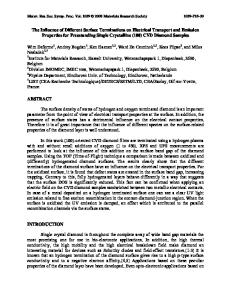The Effect of Surface Preparation on the Structure and Electrical Transport in an Organic Semiconductor
- PDF / 1,164,402 Bytes
- 6 Pages / 612 x 792 pts (letter) Page_size
- 78 Downloads / 300 Views
The Effect of Surface Preparation on the Structure and Electrical Transport in an Organic Semiconductor Laura L. Kosbar, Christos D. Dimitrakopoulos, and Debra J. Mascaro1 IBM T.J. Watson Research Center, Yorktown Heights, NY 10598, U.S.A. 1 Department of Materials Science and Engineering, MIT Cambridge, MA 02139.
ABSTRACT Self-assembled monolayers (SAMs) with a variety of structures and terminal groups were evaluated as underlayers for pentacene deposition. It was found that the most critical factor in the formation of highly oriented thin film pentacene with large grain size was the geometric structure of the monolayer. Monolayers with terminal bonds parallel to the surface produce large pentacene grains with an angular rather than the dendridic structure normally observed on octadecyltrichlorosilane (OTS) coated substrates. The grain size, X-ray scattering, carrier mobility, and current on/off ratios are all improved with monolayers of the appropriate geometry. INTRODUCTION Organic thin films have attracted considerable research interest due to their potential use as an alternative to inorganic semiconductors for large area electronics applications. Many organic materials, such as pentacene and sexithiophene, have performance properties that are competitive with amorphous silicon [1-9]. Characteristics such as film flexibility and room temperature deposition processes make organic thin films suitable candidates for use in existing or future applications requiring large area coverage, mechanical flexibility, low –temperature processing, and low overall cost. Such applications include thin-film transistor (TFT) switching devices for active matrix liquid crystal displays, active matrix organic light-emitting diode displays, and low-end data storage such as smart cards and identification tags. The organic semiconductors that have demonstrated the best electrical characteristics to date are generally small molecule semiconductors that have a strong tendency to form molecular crystals. The electrical performance of the organic thin films (OTF) at room temperature is believed to be dominated by intermolecular transport such that disorder, defects, and chemical impurities within the film can form trapping sites [10]. It is generally accepted that increased ordering of the molecules in the OTF, especially in the first few monolayers deposited onto the substrate, will improve the mobility of charge carriers in the film. The deposition conditions as well as the state of the substrate surface onto which the pentacene is deposited can have significant influence on the ordering and crystallinity of vapor deposited pentacene. Substrate temperature and deposition rate have been shown to affect the structure and size of the deposited pentacene crystals and the mobility of the deposited film [11,12]. A technique that has been reported to achieve improved pentacene deposition and electrical performance is the use of self-assembled monolayers (SAMs) of alkyl silanes (such as octadecyltrichlorosilane (OTS)) on silicon dioxide or gla
Data Loading...




